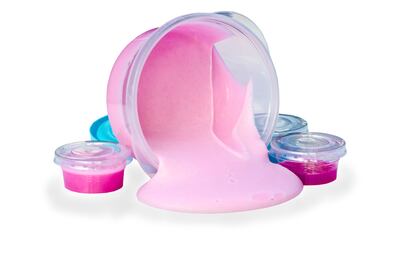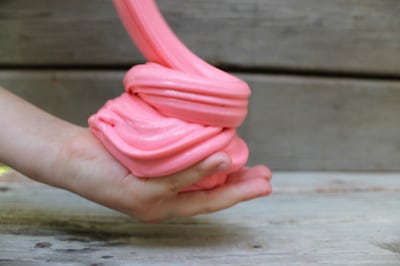It is when I have managed to superglue my sock to the floor, and am navigating a laptop keyboard with my elbow to avoid sticking to it, that I realise I will never make it as a professional slimer.
If you don’t know what a slimer is, you probably don’t have children or young people in your life. But it’s not just kids that are into slime. It’s adults looking for a stress relief or a distraction. Or anybody looking to make money. In some cases, big money. Slime.
Not some new-fangled slime – proper old-school slime. Goo, gunge, gunk. A mixture of glue, water, sugar and some form of activating agent and dye, although the exact ingredients are a matter of debate, preference and tightly kept secrets. Slime is the jazzier, more fun, Instagram-friendly cousin of Play-Doh or putty, and has exploded as an interest: shops sell out of ingredients; YouTube tutorials are watched by millions; books are published; venues are booked for "slime parties"; carpets (I am told this a lot) are wrecked.

I wasn’t convinced at first that slime was a real trend, a grassroots interest, as opposed to one manufactured by Big Toy (I imagine a toy-world head honcho stroking a stuffed cat).
Then I get the emails from parents.
Michael: “I have a daughter who loves slime, enjoys making slime, gets slime all over the place and pesters the life out of us about slime.”
Emma: “I have a nine-year-old son. He is drawn to the pots in every toy shop.”
Lizanne: “My nine-year-old loves slime. In sticky piles left on the kitchen table. In litre-tubs home-made by her cousin, replete with glitter.”
Then there are the messages such as this from Paul: “Rosa absolutely loves slime – both making it using instructions from YouTube and buying it from shops. We HATE the stuff!”
From Polly: “My daughter completely RUINED the carpet in her bedroom (I mean, it is fucked, really).” I hear the word slime so much the sound starts to slip and slide in my head.
When I was at school, there was a craze for slimy aliens, which came in small eggs and usually ended up on classroom ceilings (and, now, on 90s nostalgia websites). One Twitter user points out that buckets of gunk dropped on contestants' heads were a mainstay of 80s television shows. The wildly popular Gooosebumps books had a slime-based titular font. So it has clearly long been appealing. But that is a far cry from 13-year-old slime entrepreneurs such as Theresa Nguyen, who earns $3,000 (€2,425) a month from adverts on her YouTube videos or through sales of her creations.
If you search 'slime' on YouTube today, you will get 29 million results
On Google Trends, a tool that collates search information history, I try to work out when this trend began. Before 2015 there's nothing. Summer 2016, slime-based queries begin to rise. Then, at the beginning of 2017, boom: slime explosion, stickiness dripping down the walls. If you search "slime" on YouTube today, you will get 29 million results. On Instagram, there are 20 million posts with slime-related hashtags. Slime now accounts for a quarter of Argos's Arts & Crafts range, whereas it didn't even have slime products on the market this time last year.
Meanwhile, thanks to the slime boom, a struggling glue factory in France has seen a reversal in its fortunes, while other retailers are having difficulty replenishing stocks of glue.
For 18-year-old Canadian YouTube star ItsJustNick, this adds up to 1.2 million subscribers to his channel and 6.7 million views for a single slime-themed video. I ask Nick by phone how and why he first began making slime videos. As an astute YouTuber, he tells me he followed the trend when he saw lower-profile videos. But Nick says that I need to understand there is more to slime than meets the eye.
“My first DIY slime video, I was being fun with it. I started getting followers because of that. I did my research on slime. I figured out that there’s so much behind slime, different types of slime, slime shops, terms for slime. You get really into it. With slime there are smaller trends within the big trend of slime. If I did the water-based video now [Nick’s biggest slime video to date], it wouldn’t get as many views as two months ago.”
So there are subsets of slime? Right, he says. There is fluffy slime, with a cloud-like texture. Rainbow-coloured slime. Glitter and sequin slime. The slime is endless. And unlike other, more passive trends that have boomed online, slime translates into real-life activity. It is back-to-basics arts and crafts. Parents seem to be pleased that their children are doing something creative and wholesome. But don’t get things twisted: the kids take it seriously.
Rachel Clarke and her kids email me from Orlando, Florida, where they are visiting Disney World. Clarke is a prominent doctor who has written a book, Your Life in My Hands, about working in the NHS, so it perhaps shouldn't be surprising that her children, Finn, (11), and Abbey, (7), are budding scientists. But I am still wowed by what they tell me.
Clarke says that she appreciates the scientific learning that’s possible through slime, and for Finn the appeal is definitely “the satisfaction of feeling your own creation and knowing that you made it. I also love playing with it, it’s incredibly addictive. You can spend hours just fiddling with it.”
For kids, it seems slime is a squishier fidget-spinner.
When I ask for tips on making my own slime, Finn comes into his own. “The most important thing about slime is to always – always – use an activator. This is something that pulls the slime together, like contact lens solution or bicarbonate of soda. Then, if you like fluffy slime, use shaving cream. If you like gooey slime, use PVA glue and laundry detergent. This works amazingly, but only for a short while. Then it turns hard.”
His sister has another tip: “Only add little bits of the ingredients at a time, even if you think you don’t have enough, otherwise you might add too much.”
Clarke tells me: “The children are now fighting – and Abbey is actually weeping – in their desire to tell you all their slime thoughts.”
Finn’s favourite slime colours are blue and orange. But Abbey is a slime realist: “The best colour for slime is green because then it looks like actual real slime.”

Other kids (and parents) say that slime is fun because it is a collaborative activity, with kids meeting up and swapping tips. And it is also lucrative. There has been a boom in slimers selling their own creations in school and online. Polly Birkbeck’s daughter, Stella, used to take her creations into school to sell (Birkbeck sends me a picture of her daughter in a huge, homemade slime bubble, a sort of slime sleeping bag). Michelle’s daughter, Kiki, runs Koala Slime, a slime shop on Etsy, mixing, scenting and packaging the product herself (variations include “watermelon candy”). Her mother estimates that Kiki has made €1,700 since she set up shop in October.
Karina Garcia, who is 24 and from California, is a doyenne of the slime world. She has 7 million subscribers on YouTube, sells her own slime kits and has published three books with Simon & Schuster. I try to speak to her, but she is busy uploading cryptic posts on Instagram, which I eventually work out spell "TOUR DATES WEDNESDAY". (I got in touch with YouTuber Nick via his agent, which tells you something about how big business YouTube slime channels now are.)
But it’s not all about the money. Nick mentions the ASMR qualities of slime. ASMR – autonomous sensory meridian response, booming YouTube industry in itself – is the practice of creating relaxing soundscapes with everyday objects, or recreating the sounds of processes, such as a haircut, or a Biro on paper, that some find soothing. I am a fan and have used these videos to get to sleep. Nick says that ASMR slime is one of those slime subsets he talked about. “People turn the volume right up, and listen to the sounds of slime.”
In practice, too, slime can be healing. Nelly Curtis is an art therapist working in London. She uses slime in her sessions. "Slime has very sensory, stimulating qualities, which can help regulate emotions. But for some clients, perhaps those who are on the autistic spectrum, slime would be difficult to cope with, but they find that playing with dough is calming. Also, dealing with mess is often the aim of therapy, so feelings can be evoked through the making and playing with the mess."
This goes for adults, too. Ilayda Arden, (29), is a writer and actor who is into slime. In particular, “purple, glittery and glorious” slime. What Arden says mirrors Curtis’s point. “The calming bit comes from using the biggest glob of slime to pick up the smaller pieces and bringing it all back together into one and kind of making myself clean again.” It’s similar to how she likes cooking. Or, pimple-popping videos that – stay with me – are a sort of proxy stress reliever with their own YouTube community.
I discover a possible dark side: slime as a sort of evil, destructive ectoplasm
But just when I’m thinking slime is a Force for Good, I discover a possible dark side: slime as a sort of evil, destructive ectoplasm. Or as one Mumsnet user puts it, more prosaically: “Slime is awful for the environment. You’re creating a polymer that will stay on the planet for ever.”
My friend, Joe, who is a teacher, also mentions a “slime-related cyber-bullying incident, the most 2018 thing ever”. But it seems to me the most menacing thing about slime is how it wreaks havoc on washing machines, jumpers and Subbuteo mats, as one exasperated parent tells me.
I decide that I must try slime for myself. I could tell you I decided to make it from scratch specifically because I had Finn’s words ringing in my ears (“I would never use shop-bought slime, making it is the whole point”), but mostly it is because Argos has run out of the ready-made. But this is fine. I got an A in chemistry at school. (I shush the internal voice that reminds me that this was because of my theory essays rather than my practical scores.)

The good news is my flat doesn’t have carpets. The bad news is that I lose multiple decorative googly eyes between the floorboards. Glitter, meanwhile, is at least 40 per cent of the reason I don’t have children, so when I start to add it to the mix, rather than helping me to relax, it makes me panic. After mixing it together, I have what looks like either a sparkling umbilical cord staring at me (the googly eyes) or a bruised piece of chewing gum. I somehow don’t think I would be able to make any money selling it. It doesn’t smell of chemicals though, as some parents said – just the whiff of failure.
By definition, trends come and go. Surely slime is on its way out? Birkbeck says her daughter has moved on to makeup. Emilie tells me that her child played with slime “every day for a single year, then suddenly stopped”.
But YouTuber Nick isn’t so sure. He is now doing slime dare videos (astute as ever, he refuses to eat it), and thinks that slime will be around for a while yet.
Isn’t he getting bored with the slime?
He pauses. “I enjoy the videos. As long as people are happy. But I always have the thought in the back of my head: what’s the next thing?”
– Guardian










